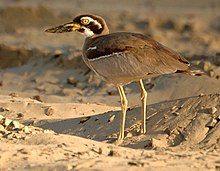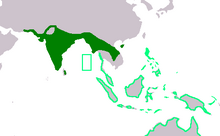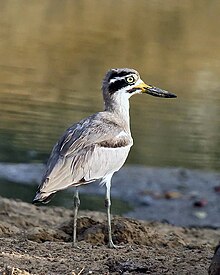
The stone-curlews, also known as dikkops or thick-knees, consist of 10 species within the family Burhinidae, and are found throughout the tropical and temperate parts of the world, with two or more species occurring in some areas of Africa, Asia, and Australia. Despite the group being classified as waders, most species have a preference for arid or semiarid habitats.

The rockjumpers are medium-sized insectivorous or omnivorous birds in the genus Chaetops, which constitutes the entire family Chaetopidae. The two species, the Cape rockjumper, Chaetops frenatus, and the Drakensberg rockjumper, Chaetops aurantius, are endemic residents of southern Africa. The Cape rockjumper is a resident of the West Cape and south-west East Cape, and the orange-breasted rockjumper is distributed in the Lesotho Highlands and areas surrounding them in South Africa. The two rockjumpers have been treated as separate species but differ in size and plumage. The ranges do not overlap, but come close to doing so. Also found in the mountain of a small town Middelburg in the eastern Cape where they are protected because they are endangered species.

The great stone-curlew or great thick-knee is a large wader which is a resident breeder in tropical southern Asia from India, Pakistan, Sri Lanka, Bangladesh into South-east Asia.

The silverbird is an Old World flycatcher native to Eastern Africa, from Sudan to Tanzania. The species is the only member of the genus Empidornis, although it is sometimes placed in the genus Melaenornis .

The caribs are a genus, Eulampis, of hummingbirds in the family Trochilidae. The genus contains two species, both of which are endemic to the islands of the Caribbean. The genus name comes from the Ancient Greek word eulampēs meaning 'bright shining'.
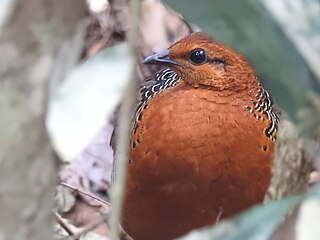
The ferruginous partridge is a species of bird in the family Phasianidae. It belongs to the monotypical genus Caloperdix. It is found in Indonesia, Malaysia, Myanmar, and Thailand.

The Apo myna is a species of starling in the starling family Sturnidae. The species is also known as the Mount Apo starling or the Mount Apo king starling. It is the only member of the genus Goodfellowia. It is endemic to the Philippines found only in the tropical montane forests of Mindanao. It is threatened by habitat loss.

The short-legged ground roller is a species of bird in the ground roller family Brachypteraciidae. It is the only living species in the genus Brachypteracias and is endemic to Madagascar. It is threatened by habitat loss.

Agelasticus is a genus of birds in the New World oriole family Icteridae. They have slender forms and thin bills. The females are responsible for building the nest, unlike some of their close relatives. The genus is found in South America.
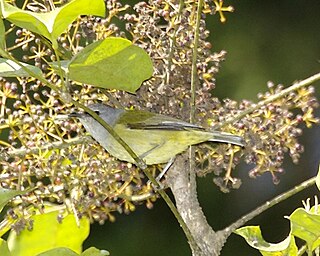
Heleia is a genus of birds in the white-eye family Zosteropidae. One species, the spot-breasted heleia is restricted to the island of Timor. The pygmy white-eye is endemic to the island of Borneo. The thick-billed heleia, occurs on Flores and Sumbawa.

The crimson-fronted cardinal is a bird species in the tanager family (Thraupidae). It is not very closely related to the cardinals proper (Cardinalidae). It is endemic to Brazil.
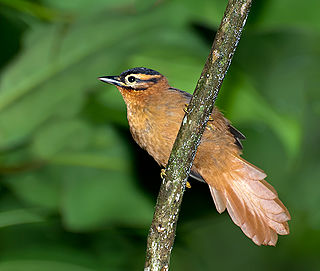
Philydor is a genus of foliage-gleaners, birds in the ovenbird family Furnariidae. It contains the following species:
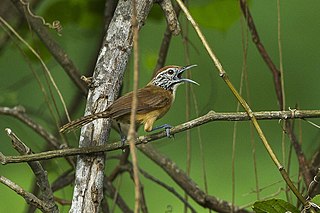
The happy wren is a species of bird in the family Troglodytidae. It is endemic to the Pacific slope of western Mexico, from the state of Sonora to the state of Oaxaca, and also on islands west of the Mexican coast. As with other species of Pheugopedius, older sources classify it within genus Thryothorus. Some authorities have treated it as a subspecies of P. rutilus or P. sclateri. There is significant geographical variation, and six subspecies are recognized: P. f. sonorae is found in southern Sonora and northern Sinaloa; P. f. pallidus is found in central Sinaloa, western Durango and southwards to Jalisco and Michoacán; P. f. lawrencii and P. f. magdalenae are found on different islands of the Islas Marías; P. f. grandis is found in the Balsas River basin, and the nominate subspecies, P. f. felix in southwestern Mexico from Jalisco to Oaxaca.

Lafresnaye's vanga is a species of bird in the vanga family Vangidae. The species is monotypic and one of three species in the genus Xenopirostris. It is endemic to the south and south west of Madagascar. It inhabits sub-arid thorn scrub, in the Madagascar spiny forests ecoregion, particularly areas with large amounts of dead wood, from sea level to 100 m (330 ft). The species has a small range is not common within that range. It was uplisted from Least Concern to Near Threatened in 2022 as it is experiencing moderately rapid population decline owing to habitat degradation and loss within its range.

The Andaman woodpecker is a species of bird in the woodpecker family Picidae. It is endemic to the Andaman Islands in India. Its natural habitat is tropical moist lowland forests. It is threatened by habitat loss.

The pallid honeyguide is a species of bird in the family Indicatoridae. The species is also known as the eastern least honyeguide. It is found in Angola, Democratic Republic of the Congo, Kenya, Malawi, Mozambique, Tanzania, Uganda, Zambia, and Zimbabwe.

Burhinus is a genus of birds in the family Burhinidae. This family also contains the genus Esacus. The genus name Burhinus comes from the Greek bous, ox, and rhis, nose.

The water thick-knee or water dikkop is a species of bird in the thick-knee family Burhinidae. The species is found across sub-Saharan Africa, usually close to water.

Oreoicidae is a newly recognized family of small insectivorous songbirds from New Guinea and Australia, commonly known as the Australo-Papuan bellbirds. The family contains three genera, each containing a single species: Aleadryas, which contains the rufous-naped bellbird; Ornorectes, which contains the piping bellbird; and Oreoica, which contains the crested bellbird.
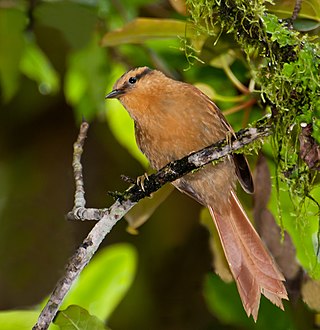
Dendroma is a genus of foliage-gleaners, birds in the ovenbird family Furnariidae. It contains the following species:
